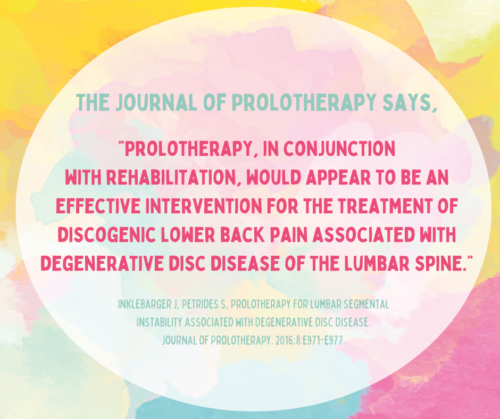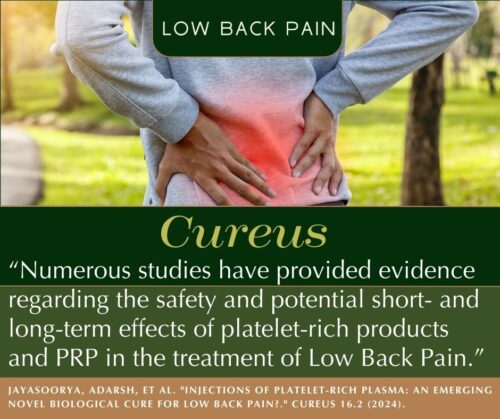If you or someone you love is suffering from back pain, you understand the search for an answer for the resolution of the pain. The search for relief can go on year after year. We believe Regenerative Orthopedics is one of the best treatments for low back pain.
At our clinic, we see back pain sufferers who have already tried many different treatment options like supplements, painkillers, anti-inflammatories, antidepressants, massage, and possibly even surgery. And sure, they may help the sufferer achieve some relief, but often, the help is only temporary.
 Why doesn’t the relief last? Unfortunately, these common treatments for back pain do not address the real problem. Sure, they may address pain or inflammation, but pain and inflammation are symptoms of the underlying problem. What is the root cause of the pain and inflammation?
Why doesn’t the relief last? Unfortunately, these common treatments for back pain do not address the real problem. Sure, they may address pain or inflammation, but pain and inflammation are symptoms of the underlying problem. What is the root cause of the pain and inflammation?
Very often, the underlying problem causing back pain is instability. Instability in the back occurs when the ligaments connecting bone to bone become injured. Once ligaments are injured, they become more lax or loose. With this laxness comes abnormal motion in the joints.
You’ve probably noticed that back pain comes and goes for many people. Back pain may be worse on some days and better on others. And when back pain is chronic, it continually comes back. Why does the pain always come back? If the underlying instability problem is not addressed, then the pain medications and anti-inflammatories only touch the symptoms of pain and inflammation. They do not repair the instability and abnormal motion in the vertebrae.
Like we said earlier, treatments like pain medications do not address the root cause. They may touch on some of the symptoms, but they don’t repair the cause. Care for chronic low back pain is often very frustrating to clinicians and patients. It’s frustrating because the commonly used treatments come up short. The Journal of Orthopaedic Surgery and Research says this, “The benefits are just not there to justify the routine prolonged use of any given drug in nonspecific chronic low back pain: this is a major challenge, and it is often hard to accept for clinicians and patients . . . ”(1)
There is also a subset of patients that have been prescribed narcotic pain relievers. Do these help long-term? The Journal of Osteopathic Medicine says, “Long-term opioid use (more than 12 months) patients had a worse disability, physical function, fatigue, and other pain-related problems including the earlier onset of sleep disturbance.”(2) As you can see, opioids do not help long-term, but rather increase disability.
Chiropractic manipulations are great treatment modalities and they are excellent for low back pain. As both a chiropractor and an MD, Dr. Fields will always recommend that a patient first seek the help of a chiropractor for back pain issues. However, if the back pain is still an issue and not resolved after the recommended treatments, ligament injury may be the issue. In cases of ligament injury, Regenerative Orthopedics should be sought, since it can effectively repair the ligament injury.
Regenerative Orthopedic treatments repair the underlying damage to the ligaments and any involved tendons. These injured soft tissues naturally have a poor blood supply. But Regenerative Orthopedics boosts the blood supply to the ligaments. This increased blood supply helps the body to heal and repair. The result? The back is strengthening, the abnormal joint motion is stabilized, and the back pain sufferer experiences decreased pain and increased function!
Even if you have disc problems, the underlying problem can likely be instability. The injured ligaments allow for abnormal motion in the vertebrae and increase problems with the discs. Spinal ligament damage is at the core of the problem.
In degenerative disc disease, the disc height increases, and the lax ligaments lose tension. The vertebrae move even more, and the lack of stabilization increases pain in the discs and other spinal joint structures.
In many instances, the common underlying low back pain complaints, including arthritis and loss of spinal curve, are largely due to ligament injury. Instability in the spine is at the root of most chronic spinal pain.
Muscles are one of the stabilizing structures of the spine. If the injury in the back is muscular, standard treatments will address the pain. The intervertebral discs and surrounding ligaments also hold together and stabilize the spine.
When these standard treatments do not solve the problem of low back pain, underlying ligament damage and spinal instability need to be addressed. And the best treatment for back pain due to ligament damage is Regenerative Orthopedics.
Over time, after a traumatic injury, the ligaments will start to elongate and become loose and lax. Physically demanding activities or even sedentary postures can lead to this gradual loosening over time. Muscle spasms will develop because of these elongated ligaments. Swelling may occur, and eventually, arthritis will develop as the body attempts to stabilize the area by creating bone spurs.
Regenerative Orthopedics strengthens the ligaments of the spine and prevents further degeneration. It gets to the underlying issue causing low back pain. Prolotherapy is a type of Regenerative Orthopedics. Researchers in the Journal of Prolotherapy say, “In comparison to other soft tissues, ligaments have less vascularity. Once injured or degenerated, this lack of blood supply may delay healing. Prolotherapy may offer the stimulus for ligament regeneration.”(3)

PRP Is an Effective Treatment for Low Back Pain
The Journal of Back and Musculoskeletal Rehabilitation concluded, “Prolotherapy can be regarded as a safe way of providing a meaningful improvement in pain and musculoskeletal function compared to the initial status. …5% dextrose is a more simple and painless solution for Prolotherapy and also has a high success.”(4)
Also, a group of researchers in a 2024 article in the medical journal Cureus showed PRP to be effective for low back pain. They say, “Compared to steroids, autologous PRP is a better therapeutic option due to its longer-lasting effectiveness, according to the research. Numerous studies have provided evidence regarding the safety and potential short- and long-term effects of platelet-rich products and PRP in the treatment of low back pain.”
Remember, when back pain is an issue, the muscles may be in spasm because they are overcompensating for the injured ligaments as they try to stabilize the spine. Chiropractic adjustments will align the spine, and Regenerative Orthopedics effectively repair the ligaments…getting to the root of the back pain problem. Additionally, in cases of degenerative disc disease, Prolotherapy tightens the ligamentous structures and limits the abnormal vertebral motion, reducing the incidence of discogenic low back pain by improving stability.
(1)Migliorini F, Maffulli N. Choosing the appropriate pharmacotherapy for nonspecific chronic low back pain. Journal of Orthopaedic Surgery and Research. 2022 Dec;17(1):1-3.
(2)Schultz MJ, Licciardone JC. The effect of long-term opioid use on back-specific disability and health-related quality of life in patients with chronic low back pain. Journal of Osteopathic Medicine. 2022 Aug 11.
(3)Inklebarger J, Petrides S, Prolotherapy for Lumbar Segmental Instability Associated with Degenerative Disc Disease. Journal of Prolotherapy. 2016;8:e971-e977.
(4)Solmaz I, Orscelik A, Koroglu O. Modified prolotherapy by 5% dextrose: Two years experiences of a traditional and complementary medicine practice center in Turkey. Journal of Back and Musculoskeletal Rehabilitation. 2021(Preprint):1-8.
(5) Jayasoorya, Adarsh, et al. “Injections of Platelet-Rich Plasma: An Emerging Novel Biological Cure for Low Back Pain?.” Cureus 16.2 (2024).